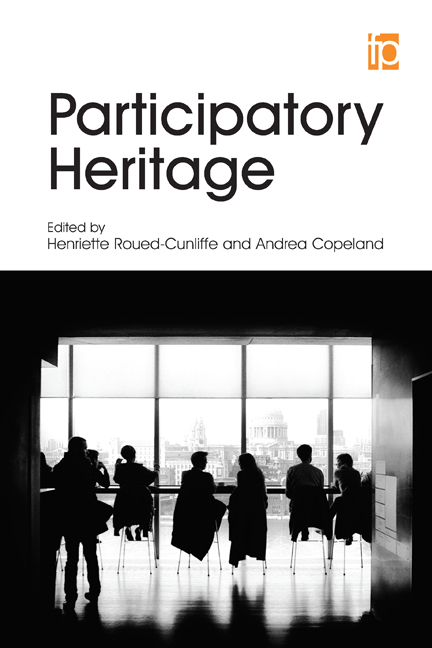Book contents
- Frontmatter
- Contents
- List of figures and tables
- Contributors
- Introduction: what is participatory heritage?
- Part 1 Participants
- Part 2 Challenges
- Part 3 Solutions
- 14 Ethiopian stories in an English landscape
- 15 Having a lovely time: localized crowdsourcing to create a 1930s street view of Bristol from a digitized postcard collection
- 16 Digital archiving in Canadian artist-run centres
- 17 New approaches to the community recording and preservation of burial space
- 18 A case for collaboration: solving practical problems in cultural heritage digitization projects
- 19 Open heritage data and APIs
- Further reading
- Index
15 - Having a lovely time: localized crowdsourcing to create a 1930s street view of Bristol from a digitized postcard collection
from Part 3 - Solutions
Published online by Cambridge University Press: 08 June 2018
- Frontmatter
- Contents
- List of figures and tables
- Contributors
- Introduction: what is participatory heritage?
- Part 1 Participants
- Part 2 Challenges
- Part 3 Solutions
- 14 Ethiopian stories in an English landscape
- 15 Having a lovely time: localized crowdsourcing to create a 1930s street view of Bristol from a digitized postcard collection
- 16 Digital archiving in Canadian artist-run centres
- 17 New approaches to the community recording and preservation of burial space
- 18 A case for collaboration: solving practical problems in cultural heritage digitization projects
- 19 Open heritage data and APIs
- Further reading
- Index
Summary
CROWDSOURCING HAS BECOME an ‘in thing’ for scholars, librarians or archivists wishing to tag, transcribe or annotate almost any substantial archive or data collection. The principal advantage of crowdsourcing, as argued by Holley (2010, 2), is that work previously carried out by organizations and their paid staff can be more cheaply and more rapidly achieved by outsourcing tasks to volunteer members of the public who give freely of their time and effort. Economically this is an attractive proposition to information professionals thinking about using crowdsourcing, but, more than this, it encourages and facilitates the public in conducting humanities research for themselves, rather than being mere consumers of the same (Piccini and Insole, 2013, 34–5). This – and to have fun doing it – was our goal in creating the Enhancing Know Your Place project.
Enhancing Know Your Place has been just one part of a larger project, Know Your Bristol on the Move (OTM), in the city of Bristol, UK. Begun in the summer of 2013 and funded to run for 18 months, OTM was a response to a research funding opportunity with an embedded emphasis on digital humanities. One work package of OTM was proposed in which an existing digital archive of mostly early 20th-century postcard picture images were to be placed within another pre-existing platform, an online historical map display of the city of Bristol, Know Your Place (http://.maps. bristol.gov.uk/kyp/).
Know Your Place is an established website that allows visitors to explore Bristol's neighbourhoods through historic maps, images and linked information. Conceived and led by the principal Historic Environment officer in Bristol's Planning Department, the website was created in partnership with Bristol Record Office (BRO) and the City Council's Geographic Information Systems (GIS) team, with funding from English Heritage. Launched in 2011, the map-based online resource provides access to a range of historic information, including historic maps and aerial surveys, photographs and illustrations from the city's archives and data from the Historic Environment Record (HER), a database of all known historical monuments and archaeological sites maintained by the local planning authority. Making use of the recent rapid developments in mapping and tracking Global Position System ‘pinpoint’ technologies, all the maps and aerial surveys are fully georeferenced, meaning that each map aligns perfectly with those arranged above and below.
- Type
- Chapter
- Information
- Participatory Heritage , pp. 153 - 162Publisher: FacetPrint publication year: 2017



